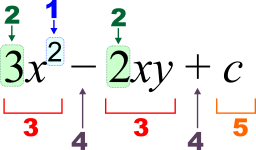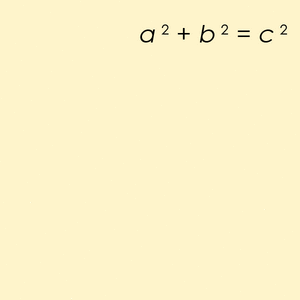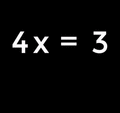Elementary algebra facts for kids
Elementary algebra is the most basic form of algebra taught to students. It is often one of the next areas of mathematics taught to students after arithmetic. While in arithmetic only numbers and operators like +, −, ×, and ÷ occur; in algebra, variables (like a, x, y) are used to stand for numbers. This is useful because:
- It lets people solve problems about "unknown" numbers. This means learning about equations and how to solve them (for example, "find a number x where
 ").
"). - It allows the generalization of the rules from arithmetic. While some students understand that
 , it helps to prove that
, it helps to prove that  for all a and b. This makes algebra a good step to learning about abstraction (learning general ideas from many examples).
for all a and b. This makes algebra a good step to learning about abstraction (learning general ideas from many examples). - It helps people understand and create functional relationships (also sometimes called cause and effect). An example of this is "if x tickets are sold, then the profit will be
 dollars".
dollars".
These three are the main strands of elementary algebra. Elementary algebra is often used in many other subjects, like science, business, and building. Abstract algebra, a much more advanced topic, is generally taught late in college.
Contents
Algebraic notation
Algebraic notation describes how algebra is written. It follows certain rules and conventions, and has its own terminology. For example, the expression  has the following components:
has the following components:

1 : Exponent (power), 2 : Coefficient, 3 : term, 4 : operator, 5 : constant,  : variables
: variables
A coefficient is a numerical value, or letter representing a numerical constant, that multiplies a variable (the operator is omitted). A term is an addend or a summand, a group of coefficients, variables, constants and exponents that may be separated from the other terms by the plus and minus operators. Letters represent variables and constants. By convention, letters at the beginning of the alphabet (e.g.  ) are typically used to represent constants, and those toward the end of the alphabet (e.g.
) are typically used to represent constants, and those toward the end of the alphabet (e.g.  and
and  ) are used to represent variables. They are usually written in italics.
) are used to represent variables. They are usually written in italics.
Algebraic operations work in the same way as arithmetic operations, such as addition, subtraction, multiplication, division and exponentiation. and are applied to algebraic variables and terms. Multiplication symbols are usually omitted, and implied when there is no space between two variables or terms, or when a coefficient is used. For example,  is written as
is written as  , and
, and  may be written
may be written  .
.
Usually terms with the highest power (exponent), are written on the left, for example,  is written to the left of
is written to the left of  . When a coefficient is one, it is usually omitted (e.g.
. When a coefficient is one, it is usually omitted (e.g.  is written
is written  ). Likewise when the exponent (power) is one, (e.g.
). Likewise when the exponent (power) is one, (e.g.  is written
is written  ). When the exponent is zero, the result is always 1 (e.g.
). When the exponent is zero, the result is always 1 (e.g.  is always rewritten to
is always rewritten to  ). However
). However  , being undefined, should not appear in an expression, and care should be taken in simplifying expressions in which variables may appear in exponents.
, being undefined, should not appear in an expression, and care should be taken in simplifying expressions in which variables may appear in exponents.
Alternative notation
Other types of notation are used in algebraic expressions when the required formatting is not available, or can not be implied, such as where only letters and symbols are available. For example, exponents are usually formatted using superscripts, e.g.  . In plain text, and in the TeX mark-up language, the caret symbol "^" represents exponents, so
. In plain text, and in the TeX mark-up language, the caret symbol "^" represents exponents, so  is written as "x^2". In programming languages such as Ada, Fortran, Perl, Python and Ruby, a double asterisk is used, so
is written as "x^2". In programming languages such as Ada, Fortran, Perl, Python and Ruby, a double asterisk is used, so  is written as "x**2". Many programming languages and calculators use a single asterisk to represent the multiplication symbol, and it must be explicitly used, for example,
is written as "x**2". Many programming languages and calculators use a single asterisk to represent the multiplication symbol, and it must be explicitly used, for example,  is written "3*x".
is written "3*x".
Simple algebra problems
If an equation has only one number that is unknown it is sometimes easy to solve. The unknown number is called "x":
To solve a simple equation with one unknown amount add, subtract, multiply, or divide both sides of the equation by the same number in order to put the unknown amount, x, on one side of the equation. Once x is by itself on one side, use arithmetic to determine the amount on the other side of the equation. For example, by subtracting 4 from both sides in the equation above:
getting:
Dividing both sides by 2:
getting:
Concepts
Variables
Elementary algebra builds on and extends arithmetic by introducing letters called variables to represent general (non-specified) numbers. This is useful for several reasons.
- Variables may represent numbers whose values are not yet known. For example, if the temperature of the current day, C, is 20 degrees higher than the temperature of the previous day, P, then the problem can be described algebraically as
 .
. - Variables allow one to describe general problems, without specifying the values of the quantities that are involved. For example, it can be stated specifically that 5 minutes is equivalent to
 seconds. A more general (algebraic) description may state that the number of seconds,
seconds. A more general (algebraic) description may state that the number of seconds,  , where m is the number of minutes.
, where m is the number of minutes. - Variables allow one to describe mathematical relationships between quantities that may vary. For example, the relationship between the circumference, c, and diameter, d, of a circle is described by
 .
. - Variables allow one to describe some mathematical properties. For example, a basic property of addition is commutativity which states that the order of numbers being added together does not matter. Commutativity is stated algebraically as
 .
.
Evaluating expressions
Algebraic expressions may be evaluated and simplified, based on the basic properties of arithmetic operations (addition, subtraction, multiplication, division and exponentiation). For example,
- Added terms are simplified using coefficients. For example,
 can be simplified as
can be simplified as  (where 3 is a numerical coefficient).
(where 3 is a numerical coefficient). - Multiplied terms are simplified using exponents. For example,
 is represented as
is represented as 
- Like terms are added together, for example,
 is written as
is written as  , because the terms containing
, because the terms containing  are added together, and, the terms containing
are added together, and, the terms containing  are added together.
are added together. - Brackets can be "multiplied out", using the distributive property. For example,
 can be written as
can be written as  which can be written as
which can be written as 
- Expressions can be factored. For example,
 , by dividing both terms by
, by dividing both terms by  can be written as
can be written as 
Equations

An equation states that two expressions are equal using the symbol for equality,  (the equals sign). One of the most well-known equations describes Pythagoras' law relating the length of the sides of a right angle triangle:
(the equals sign). One of the most well-known equations describes Pythagoras' law relating the length of the sides of a right angle triangle:
This equation states that  , representing the square of the length of the side that is the hypotenuse (the side opposite the right angle), is equal to the sum (addition) of the squares of the other two sides whose lengths are represented by
, representing the square of the length of the side that is the hypotenuse (the side opposite the right angle), is equal to the sum (addition) of the squares of the other two sides whose lengths are represented by  and
and  .
.
An equation is the claim that two expressions have the same value and are equal. Some equations are true for all values of the involved variables (such as  ); such equations are called identities. Conditional equations are true for only some values of the involved variables, e.g.
); such equations are called identities. Conditional equations are true for only some values of the involved variables, e.g.  is true only for
is true only for  and
and  . The values of the variables which make the equation true are the solutions of the equation and can be found through equation solving.
. The values of the variables which make the equation true are the solutions of the equation and can be found through equation solving.
Another type of equation is an inequality. Inequalities are used to show that one side of the equation is greater, or less, than the other. The symbols used for this are:  where
where  represents 'greater than', and
represents 'greater than', and  where
where  represents 'less than'. Just like standard equality equations, numbers can be added, subtracted, multiplied or divided. The only exception is that when multiplying or dividing by a negative number, the inequality symbol must be flipped.
represents 'less than'. Just like standard equality equations, numbers can be added, subtracted, multiplied or divided. The only exception is that when multiplying or dividing by a negative number, the inequality symbol must be flipped.
Properties of equality
By definition, equality is an equivalence relation, meaning it has the properties (a) reflexive (i.e.  ), (b) symmetric (i.e. if
), (b) symmetric (i.e. if  then
then  ) (c) transitive (i.e. if
) (c) transitive (i.e. if  and
and  then
then  ). It also satisfies the important property that if two symbols are used for equal things, then one symbol can be substituted for the other in any true statement about the first and the statement will remain true. This implies the following properties:
). It also satisfies the important property that if two symbols are used for equal things, then one symbol can be substituted for the other in any true statement about the first and the statement will remain true. This implies the following properties:
- if
 and
and  then
then  and
and  ;
; - if
 then
then  ;
; - more generally, for any function
 , if
, if  then
then  .
.
Properties of inequality
The relations less than  and greater than
and greater than  have the property of transitivity:
have the property of transitivity:
- If
 and
and  then
then  ;
; - If
 and
and  then
then  ;
; - If
 and
and  then
then  ;
; - If
 and
and  then
then  .
.
By reversing the inequation,  and
and  can be swapped, for example:
can be swapped, for example:
 is equivalent to
is equivalent to 
Substitution
Substitution is replacing the terms in an expression to create a new expression. Substituting 3 for a in the expression a*5 makes a new expression 3*5 with meaning 15. Substituting the terms of a statement makes a new statement. When the original statement is true independent of the values of the terms, the statement created by substitutions is also true. Hence definitions can be made in symbolic terms and interpreted through substitution: if  , where := means "is defined to equal", substituting 3 for
, where := means "is defined to equal", substituting 3 for  informs the reader of this statement that
informs the reader of this statement that  means 3*3=9. Often it's not known whether the statement is true independent of the values of the terms, and substitution allows one to derive restrictions on the possible values, or show what conditions the statement holds under. For example, taking the statement x+1=0, if x is substituted with 1, this imples 1+1=2=0, which is false, which implies that if x+1=0 then x can't be 1.
means 3*3=9. Often it's not known whether the statement is true independent of the values of the terms, and substitution allows one to derive restrictions on the possible values, or show what conditions the statement holds under. For example, taking the statement x+1=0, if x is substituted with 1, this imples 1+1=2=0, which is false, which implies that if x+1=0 then x can't be 1.
If x and y are integers, rationals, or real numbers, then xy=0 implies x=0 or y=0. Suppose abc=0. Then, substituting a for x and bc for y, we learn a=0 or bc=0. Then we can substitute again, letting x=b and y=c, to show that if bc=0 then b=0 or c=0. Therefore, if abc=0, then a=0 or (b=0 or c=0), so abc=0 implies a=0 or b=0 or c=0.
Consider if the original fact were stated as "ab=0 implies a=0 or b=0." Then when we say "suppose abc=0," we have a conflict of terms when we substitute. Yet the above logic is still valid to show that if abc=0 then a=0 or b=0 or c=0 if instead of letting a=a and b=bc we substitute a for a and b for bc (and with bc=0, substituting b for a and c for b). This shows that substituting for the terms in a statement isn't always the same as letting the terms from the statement equal the substituted terms. In this situation it's clear that if we substitute an expression a into the a term of the original equation, the a substituted does not refer to the a in the statement "ab=0 implies a=0 or b=0."
Images for kids
See also
 In Spanish: Álgebra elemental para niños
In Spanish: Álgebra elemental para niños









